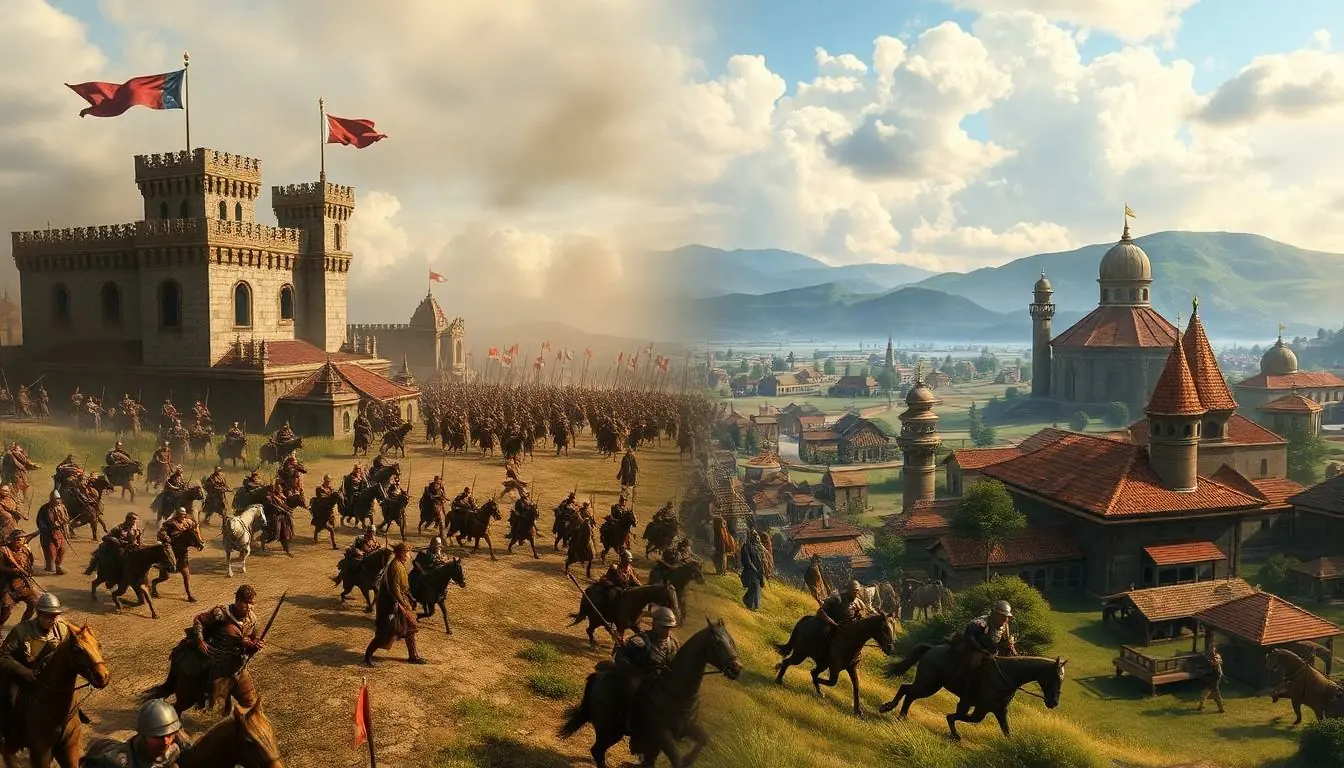Table of Contents
ToggleIn the world of real-time strategy games, the Age of Empires franchise reigns supreme. With its iconic blend of history and strategy, players have been building empires and conquering foes for decades. But now, a showdown looms on the horizon: Age of Empires II versus Age of Empires IV. It’s like watching a classic rock band face off against a shiny new pop sensation. Who will claim the crown?
Overview of Age Of Empires Series
The Age of Empires series began in 1997, revolutionizing the real-time strategy genre. This franchise emphasizes historical themes and tactical gameplay, allowing players to build empires across different eras. Each installment introduces unique civilizations, resources, and challenges, enhancing the overall experience.
Age of Empires II, released in 1999, focuses on the Middle Ages. It involves iconic civilizations such as the Franks, Byzantines, and Mongols. The game features advanced mechanics, including trade, diplomacy, and warfare, appealing to both casual and competitive players. Expansion packs further enriched gameplay with additional civilizations and campaigns.
Age of Empires IV is the latest addition, launched in October 2021. This installment returns to medieval themes while integrating modern graphics and mechanics. Players engage with new civilizations like the English, Mongols, and Delhi Sultanate. Notable changes include unique unit abilities and dynamics that reflect historical accuracy in battles and resource management.
Multiplayer modes thrive in both games. Age of Empires II supports a vibrant community with extensive online matches. Age of Empires IV also offers robust multiplayer options, allowing players to compete globally. Players engage in strategies that test their skills against opponents.
Both games provide immersive experiences rooted in history. They promote critical thinking and strategic planning, appealing to various player preferences. Age of Empires II maintains nostalgic value alongside Age of Empires IV’s modern innovations, setting the stage for ongoing debates among fans regarding which game leads the series.
Gameplay Mechanics Comparison
The gameplay mechanics of Age of Empires II and Age of Empires IV offer distinct experiences rooted in real-time strategy.
Age Of Empires 2
Age of Empires II utilizes a traditional real-time strategy format. Players gather resources to build armies and develop civilizations. Multiple civilization types, like the Franks and Byzantines, feature unique units and bonuses. Each civilization encourages varying strategies, enhancing replayability. Players engage in economic management and military tactics simultaneously. The game’s focus on medieval history allows for rich, immersive gameplay. Popular game modes include conquest and deathmatch, providing diverse challenges and experiences.
Age Of Empires 4
Age of Empires IV enhances the foundational gameplay with modern mechanics. Players interact with improved graphics and user interfaces, providing a more vibrant experience. Unique civilization abilities, like the Delhi Sultanate’s scholarly focus, reshape competitive strategies. Dynamic elements such as landmarks introduce fresh gameplay objectives. Players can use units effectively in large-scale battles or small skirmishes, emphasizing tactical depth. The inclusion of a new campaign format offers storytelling in gameplay, enriching player engagement. Multiplayer features continue to thrive, encouraging community interaction and competitive tournaments.
Graphics and Visuals
The visuals in Age of Empires II and Age of Empires IV differ significantly in style and execution, reflecting the technological advancements over time.
Age Of Empires 2
Age of Empires II features pixel art graphics that evoke nostalgia for players. The isometric view showcases distinct medieval landscapes, including fields, forests, and castles. Detailed unit designs and animations contribute to the game’s charm. Color palettes reflect the historical settings of each civilization, enhancing immersion. Although visually simpler by today’s standards, these graphics hold a timeless appeal, supporting strategic gameplay.
Age Of Empires 4
In contrast, Age of Empires IV embraces modern graphics technology, offering stunning 3D visuals. The rich environments showcase sweeping landscapes, dynamic weather systems, and intricate building details. Units exhibit realistic animations and textures, elevating the overall experience. Animated campaigns engage players through breathtaking cinematics and rich storytelling. Enhanced user interfaces streamline navigation, making it more accessible for both new and veteran players alike.
Online Multiplayer Experience
The online multiplayer experience sets these two installments apart in distinct ways.
Age Of Empires 2
Age of Empires II thrives on its established, competitive multiplayer community. Players can engage in various game modes, including ranked matches, which enhance replayability and skill development. The robust matchmaking system ensures players confront opponents of similar skill levels. Community-driven tournaments frequently highlight top players, while mods and user-generated content expand gameplay options. Players often enjoy refined strategic gameplay with unique civilization bonuses, making each match feel fresh and unpredictable. Regular updates from developers maintain game balance, ensuring that both casual and competitive players remain invested.
Age Of Empires 4
Age of Empires IV introduces innovative multiplayer features that elevate the experience. Enhanced matchmaking systems streamline the connection process, allowing players to jump into battles quickly. The newly introduced dynamic landmarks offer fresh strategic layers that influence gameplay, encouraging diverse tactics among players. Community engagement flourishes through in-game events and seasonal content, fostering connectivity. The ability to see detailed match statistics after each game provides players with insights to refine their strategies. With each update, developers prioritize community feedback, ensuring ongoing enhancements keep the gameplay engaging and competitive.
Community and Support
Age of Empires II boasts a dedicated community that has thrived since its release in 1999. Players engage actively through forums, social media platforms, and dedicated Discord servers. Regular community tournaments attract both casual and competitive players, showcasing a vibrant ecosystem.
In contrast, Age of Empires IV cultivates community support through innovative global events. Players participate in live-streamed competitions, sharing strategies and experiences. Many players appreciate the robust matchmaking system, which connects them with others of similar skill levels.
Both games benefit from developer support that prioritizes player feedback. Updates improve balance in Age of Empires II, ensuring competitive integrity. Age of Empires IV sees similar efforts, with frequent patches enhancing gameplay elements and community engagement.
Informative resources, such as wikis and YouTube channels, help players deepen their understanding of each game. Comprehensive guides for both installments cover strategies, unit compositions, and civilization mechanics. These resources encourage mastery, benefiting new players aiming to compete and veterans looking to refine their skills.
Social media platforms amplify community voices, making it easy for players to share experiences and collaborate. Twitter and Reddit hosts threads where players discuss strategies and share gameplay clips. Engagement on these platforms showcases the excitement surrounding each game’s unique features and developments.
Ultimately, both Age of Empires II and IV enjoy strong community backing, contributing to their enduring appeal in the real-time strategy genre.
Conclusion
The rivalry between Age of Empires II and Age of Empires IV showcases the evolution of real-time strategy games. Each title offers distinct experiences that cater to different player preferences. Age of Empires II captivates with its nostalgic charm and established mechanics while Age of Empires IV pushes boundaries with modern graphics and innovative gameplay features.
Both games foster vibrant communities that thrive on competition and collaboration. As players continue to engage with these titles the debate over which game reigns supreme will persist. Ultimately both installments contribute to the rich legacy of the Age of Empires franchise ensuring its place in gaming history.






